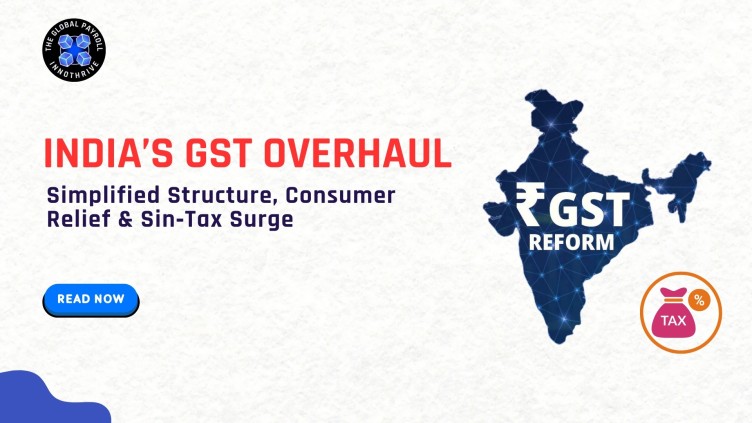India’s GST Overhaul
India’s GST Overhaul: Simplified Structure, Consumer Relief & Sin‑Tax Surge 1. Executive Summary The GST Council has carried out the most significant indirect tax reform in nearly a decade. The previous four slab system (5%, 12%, 18%, 28%) has been rationalized into a cleaner structure: 5% “merit” rate – for everyday essentials 18% standard ratefor general goods and services 40% “demerit/sin” rate – for luxury, harmful, and sin goods Additionally, individual life and health insurance policies are now GST-exempt. This reform aims to simplify compliance, reduce prices for consumers, boost demand (especially ahead of festivals), and strategically discourage consumption of harmful goods. 2. Fiscal Impact & Implementation While the government anticipates a revenue loss of ₹48,000 crore overall, this is considered manageable relative to the broader economic benefits like demand stimulation and reduced inflation pressure (estimated up to 1.1 percentage points). Effective Date: September 22, 2025 (the first day of Navratri), except for some sin goods where the shift may follow later, based on compensation cess obligations. 3. Industry Wise Tax Impact Table Industry / Category Previous GST Rate(s) New GST Rate Impact Summary Daily essentials (soap, shampoo, toothpaste, hair oil, utensils, feeding bottles, diapers, namkeen, chocolates, noodles) 12–18% 5% Significant cost reduction increases affordability and demand. Food staples (UHT milk, paneer, Indian breads like roti/paratha) 5% or 12% Nil Lifeline relief for households. Healthcare & drugs (life‑saving medicines, medical devices, spectacles, diagnostics) 12–18% 5% or Nil Makes critical healthcare and equipment more accessible. Insurance (individual life & health) 18% Nil Major affordability gain and coverage expansion. Education materials (books, pencils, exercise notebooks, maps) 12% Nil Relief for educational spending. Agriculture & farming equipment (tractors, drip systems, seeds, handicrafts, renewable equipment) 12–18% 5% Boosts these sectors through reduced taxation. Construction & building (cement) 28% 18% Moderate tax relief for the sector. Automobile & auto parts (small cars ≤350 cc, bikes ≤350 cc, three-wheelers, buses, ambulances, small trucks, all auto parts) 28% 18% Reduced tax to boost automotive and accessory demand. Electronics & appliances (ACs, TVs >32”, dishwashers, monitors, projectors) 28% 18% Significant relief for consumers. Luxury / sin goods (pan masala, cigarettes, gutkha, chews, sugary & caffeinated drinks, luxury cars, motorcycles >350 cc, yachts, personal aircraft, gambling) 28% or with Compensation Cess 40% Disincentive pricing for harmful/luxury items; conversion to GST‑only base enhances tax simplicity. 4. Strategic Implications for Businesses Consumer goods companies (FMCG, dairy, toiletries) may experience volume growth due to lower GST. Automotive and appliance manufacturers could see demand stimulation ahead of Diwali. Healthcare providers, educators, and insurers gain through cost reductions and extended coverage. Luxury segments and sin goods producers will face reduced demand due to steep taxation. Agri equipment and rural-focused manufacturers may benefit from lower tax burden stimulating rural purchasing. 5. Communication Tips for Businesses Highlight cost savings in marketing (e.g., “Now just 5% GST on XYZ product”). Reassess pricing strategies immediately to remain competitive. Prepare for demand boost The festive period—optimize inventory and logistics. Luxury goods producers might consider premium positioning or repositioning due to reduced affordability. Agritech and green energy suppliers can push outreach emphasizing lower taxation. Conclusion The GST reform is a milestone—simplifying the tax structure, cutting costs for millions, and encouraging healthier consumption patterns while maintaining revenue balance. It’s a win for compliance, consumers, and businesses ready to realign with this new landscape.
India’s GST Overhaul Read More »

















